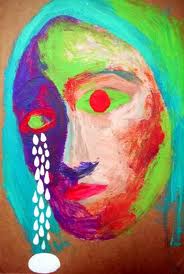Dr. V.K.Maheshwari, M.A(Socio, Phil) B.Se. M. Ed, Ph.D
Former Principal, K.L.D.A.V.(P.G) College, Roorkee, India
Sometimes when we weep in the movies we weep for ourselves or for a life unlived. Or we even go to the movies because we want to resist the emotion that’s there in front of us. I think there is always a catharsis that I look for and that makes the movie experience worthwhile.
~Edward Zwick
Abreaction is an automatic, unconscious reaction that a person has in response to a stimulus, which reminds the person of a situation they experienced before. It is the bringing to the surface of unpleasant suppressed thoughts and feelings in such a way that their being felt, emotionally, out in the open, lessens their power or hold over a person, and sometimes can seem to extinguish them completely. Abreaction is like a reverse lightning-rod, for it can “ground” tempestuous psychic energies that exist inside a person, in order that such energies will lose their power on the outside.
With roots in ancient religious practices of purification and cleansing and in ancient medicine’s purging’s, Plato evolved a verbal catharsis for diseases of the soul, and Aristotle developed a catharsis of the passions through tragic drama. Through the centuries, most cultures have had recognized contexts in which emotions were evoked, heightened in intensity, and ultimately released or discharged; and cathartic procedures can be detected in many cultures’ healing practices. The late decades of the nineteenth century saw the emergence of numerous psychological healings with a cathartic basis. Catharsis came to mean the lively remembering of a traumatic experience in addition to the emotional release; and the term abreaction frequently was used to refer to the emotional release..
The principle of catharsis has been generally recognized as important since Aristotle’s discussion of it. To have ‘a good cry’ is a well known popular remedy for emotional stress; . Freud earlier writings seemed to give new emphasis and precision to the practice of catharsis. In early papers he described a process which he proposed to call the ABREACTION of repressed emotions, ascribing great therapeutic value to it.. The assumption underlying the practice of abreaction was the forgotten or repressed ‘ideas’ were beset by a charge of emotional energy or Libido; and that process of abreaction discharges this energy from the system and thus gets rid of what was a sort of irritant, comparable to a foreign body encysted in a living tissue.
Some psychologists give great importance to abreaction. Dr O Pfister, for example, in a section headed ‘The Necessity for Abreaction ‘ writes : “If an idea accompanied by strong emotion is re[pressed and fortified by its autistic gain of pleasure, the instinct to which this idea belongs, suffers, with in a circle of activity, a damming up which often persists for a life time…. That which was buried remains unchanged under the thick covering, under excavation it disintegrates;….. the analysis first creates the possibility of freeing the imprisoned instinct.” But he does not seem to be content with the notion of abreaction as a simple discharge of a bottled-up quantity of energy. He speaks of the abreaction as “ outlet by expressive movement and associative connection,” but also as a “ mental outcropping of the unconscious which exposes it to the light of consciousness; thus with the becoming conscious and acceptance of the analytic interpretation, the manifestation will have to fade… like a developed but unfixed photographic negative in the daylight.” Here Pfister puts forward a somewhat crude view of the curative process that has enjoyed a certain vogue, the view that consciousness is a sort of light which like sunlight , has antiseptic power, and that this power deodorizes and renders harmless in some mysterious fashion, the stinking complexes hauled up from the depths of “ the unconscious.”
Dr. William Brown has made the most whole-hearted recent defense of Abreaction. “Dr. Bwon’s paper raises some very difficult and important questions which go far beyond that of the therapeutic value of ‘abreaction’.
“The immediate practical question is – Does ‘abreaction,’ the revival of the emotion which is presumed to have accompanied the disturbing experience and to have played some part in bringing on the neurotic symptoms—does this, in itself, relieve the symptoms or play any direct and essential part in curing the disorder?
“Those who return a positive answer to this question seem to take their stand on two distinct grounds.
“(1) They claim to have observed that relief of symptoms does often follow immediately upon such ‘ abreaction.’
“(2) They offer an explanation of this relief; which explanation, they claim, renders the alleged facts intelligible and brings them into line with more general principles of the mental life. The more general principle chiefly concerned is the Freudian conception of an emotion as a quantum of energy, comparable to a charge of electricity, which may become attached to any idea, and many remain so attached through long periods of time without giving any sign of activity or change; or may become detached from one idea and reattached to another, giving to it dynamic properties and various capacities for playing havoc with the life of the patient. Some such conception of the emotions seems to underlie the Freudian principles of ‘transference,’ ‘transposition,’ and ‘sublimation’ as well as ‘abreaction.’
Those of us who are not inclined to accept Prof. Freud’s every suggestion as established truth will feel that this way of conceiving emotions smacks too much of the old theory of ideas, according to which an idea is an entity capable of being somehow stored in the mind and brought out for further use on successive occasions. And we shall fear that the acceptance of this way of describing the facts of our emotional life may lead to much the same difficulties, confusions, and errors as those which are now generally recognized to be the inevitable results of the acceptance of the ‘idea’ theory.
The present and the past coexist, but the past shouldn’t be in flashback.
~Alain Resnais


